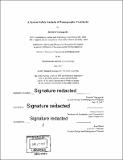A system safety analysis of tomographic treatment
Author(s)
Yamaguchi, Shinichi, S.M. Massachusetts Institute of Technology
DownloadFull printable version (9.003Mb)
Other Contributors
System Design and Management Program.
Advisor
Nancy Leveson.
Terms of use
Metadata
Show full item recordAbstract
In recent years, the technology in the medical industry has been advancing to provide safe and systematic medical care. However, the system of medical technologies and treatments has become more complicated year by year, which increases the risks of defects in the system. For example, the U.S. Food and Drug Administration's Center for Devices and Radiologic Health has reported recalls of medical devices that may lead to serious injury or death because of malfunctions. To reduce the risks, developers and makers of medical devices have been applying a wide spectrum of methodologies to improve quality. However, the growing complexity of medical systems, including devices, medical staff, organizations, and regulators, causes problems that the current safety engineering techniques are inadequate to prevent, which can result in tragic medical accidents. Therefore, it is important to apply new approaches to ensure the system safety of medical devices. This thesis compares Failure Mode and Effect Analysis (FMEA) and System-Theoretic Process Analysis (STPA). STPA is one of the analysis techniques based on the systems-theoretic approach of system safety (STAMP) to identify what should be done to establish the design safety of medical systems. Presently, FMEA, as a risk management technique, is widely used as a major methodology to ensure the safety of medical devices; therefore, it is worth comparing with STPA as a fundamental methodology. This thesis identifies the basic design of tomographic treatment and applies STPA to the TomoTherapy system. This tomographic treatment system treats hard-to-reach tumors and reduces radiation exposure to nearby healthy tissues. To ensure the quality of TomoTherapy, STPA is an effective means to conduct hazard analyses because STPA holistically analyzes the safety of this system, considering both human and mechanical factors. After that, I compare the results of STPA and FMEA. STPA analysis found 99 unsafe control actions, 10 causal scenarios, and 29 possible requirements, in contrast with FMEA, which identified a total of 74 failure modes. The potential causes of failure in the results of FMEA include only human factors. However, STPA analyzes the system from various viewpoints, such as the physical system, human factors, organization, management, and so on. Thus, it can be seen that STPA can be used as a technique to identify potential causes as causal scenarios more comprehensively than FMEA.
Description
Thesis: S.M. in Engineering and Management, Massachusetts Institute of Technology, System Design and Management Program, 2017. Cataloged from PDF version of thesis. Includes bibliographical references.
Date issued
2017Department
Massachusetts Institute of Technology. Engineering and Management Program; System Design and Management Program.; Massachusetts Institute of Technology. Integrated Design and Management ProgramPublisher
Massachusetts Institute of Technology
Keywords
Engineering and Management Program., Integrated Design and Management Program., System Design and Management Program.